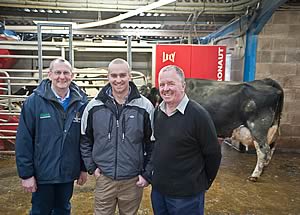 |
|||||||||
|
|||||||||||||||||||
|
|
Robotic Milking System Realises Full Yield Potential Fine-tuning the robotic milking system at Mason House Farm, Bashall Eaves, near Clitheroe, has helped restore milk yields.
The Hartley family decided to install two Lely Astronaut A3 robots three years ago for their 140-cow pedigree Roughwood Holstein herd, replacing an eight point abreast parlour which was more than 30 years old. However, John Hartley, whose son Ben returned from university four years ago, believed that while there were cow health and welfare benefits with the new system, the cows were not achieving their full yield potential. The 300-acre tenanted Mason House is one of six RDPE Northwest Livestock Programme monitor farms - three dairy and three beef and sheep, in Cumbria, Lancashire and Cheshire - which encourage farmers to discuss new ideas and share information to improve performance on North West farms – looking at animal health and welfare, nutrient management and resource efficiency. At a farm walk at Mason House on Tuesday (Nov 8) organised by the Programme, which is co-ordinated by Myerscough College and supported by industry specialists, producers were told how yields had been improving since last winter when it was decided to reduce the number of cows being milked by each unit, improve silage quality and alter the feed trough to lift forage intakes. The decision was made in March following discussions with other robotic users and industry experts. Since then the number of cow visits per robot has risen from 2.5 to 2.9 a day with the result that the average daily yield has risen by more than two litres a cow. The 12 month rolling average daily yield is up from 27.3 litres a year ago to 29.5 litres for 141 cows with rolling annual average yields increasing from 8,403 litres to 8,641 litres. At the same time concentrate use has dropped from 0.33kg a litre to 0.31kg litre. “The number of milkers had gone up to 130 and we were milking 65 cows on each robot but we felt we should be getting more milk,” said Ben. “In discussion with other robot users, we found that most were milking between 50 and 60 cows with each unit so we took off the late lactation cows which has allowed the other higher yielders to have free access and encourage more timid cows to visit more frequently. “If the cows are more relaxed they come to be milked every eight hours and we are getting up to three milkings a day. Now we are planning to install a third robotic unit next year,” he added. From discussions at on farm meetings held this year with other local dairy farmers, the out of parlour feeders have been moved and split into a 2 and 1, rather than a bank of three, with space to add a fourth, reducing the possibility of bullying and giving the cows more space to move around the building. Since moving the out of parlour feeders, the feed trough has also been extended to give more feed space per head and increase forage intakes, which should, in turn, lead to the cows lying down for longer periods. The area will eventually be roofed over to increase the accommodation to 165 head. “I think feeding a TMR would get the best from the robotic system but we are only feeding silage in the trough. We have tried growing wholecrop but the farm is too wet. /we may consider having the crop grown on contract and clamping it here,” said Ben. Silage quality has been improved this year by cutting earlier. Three cuts were taken. The Hartleys are aiming for a 10,000 litre rolling average yield. They are working with Kite consultant, Ros Hughes, who analysed the financial figures for 2010-2011 and they compare well with the top 25 per cent of Kite producers. There are now three years’ DairyCo Milkbench+ figures for comparison, which due to the attention to detail and hard work by John and Ben in monitoring performance, have seen a significant rise in net margin/litre from -1.56, due in part to high culling figures, to 2.61 pence/litre. This ability to link physical and financial indicators is now being used to help make future management changes based on the benchmarking information provided. A new dry cow building was erected in autumn 2010 which was initially tried as a composted bed but this was abandoned because of the damp climate in favour of ash bedding which at £20 a tonne is cheaper than sawdust. Currently the building is split into three sections - for transitional and lame cows, for those nearest to calving and a feeding area for the dry cows in cubicles. With proposed herd expansion to 165 cows, it is now planned to install cow comfort cubicles in the building and erect another building for dry cows behind the main building. The calf and youngstock rearing is the focus of the next meeting at Mason House on November 22, with DairyCo’s Chris Coxon.
|
||||||||||||||||||

|
|
||||||||||||||||||
| home | agri-services | pedigree
pen | news | dairy | beef | machinery property | organisations | site map |
|||||||||||||||||||

